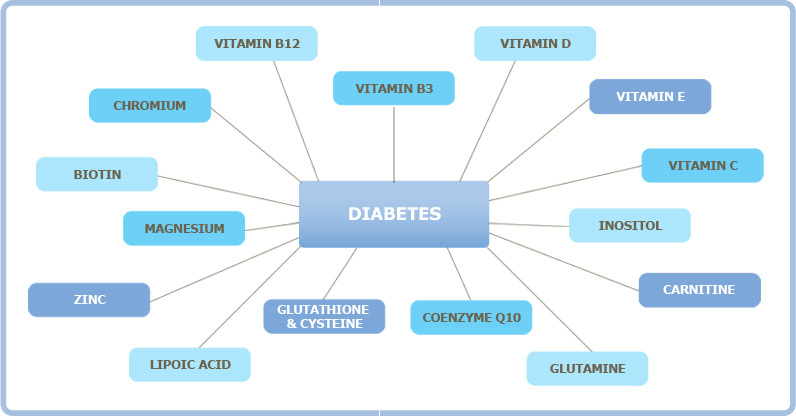 BIO-MONITORS
BIO-MONITORS
- Elevated levels of HgbA1c indicate poor glucose control and increased
risk endothelial damage.
- HgA1c measures the average
glucose over the past 2-3 months by measuring the
amount of glucose accumulated on the surface of a
red blood cell.
- Individuals with poor control or high HbA1c levels
are at risk for microvascular & macrovascular
damage independent of lipid levels, as well as risk
for atherogenic dyslipidemia.
- For individuals who are not well controlled,
use the lipid panel and lipoprotein subfractions
to help make decisions in lipid lowering and lifestyle therapy.
- Repeat
quarterly until treatment goal is met, then every
6 months.
- Cystatin C is a marker of renal function and risk stratification of heart failure. High levels are
consistently predictive of a cardiovascular event or adverse outcome.
- Cystatin C is a serum protein that is filtered out of the blood by
the kidneys. It is steadily produced by cells in the body, and its
low molecular weight allows it to be freely filtered by the glomerular
membrane. Cystatin C levels are very sensitive to
even small changes in GFR or mild renal impairment.
- Cystatin C levels are independent of weight, height,
muscle mass, age or gender.
- Its concentration in
the blood correlates with GFR, and studies show it
is a better marker of kidney function than creatinine.
- Treat underlying cause of renal disease. Assess endothelial function and consider lipid lowering therapy and lifestyle changes.
- Repeat abnormal results every 3 to 6 months until goal met or stable,
then annually.
- Ongoing elevated fasting glucose is a sign of insulin resistance generally leading to diabetes
and/or cardiovascular disease.
- Insulin resistance induces endothelial injury and the cascade of
events leading to plaque aggregation. These damages can exist years
before glucose becomes elevated.
- Elevated fasting glucose can cause
microvascular changes to the kidneys, nerves and
eyes.
- For individuals with diabetes or prediabetes, consider endothelial
function testing to guide how aggressive to be with
lipid and blood pressure lowering therapy and lifestyle changes, especially
if A1c and insulin levels are also elevated.
- Repeat quarterly until
treatment goal met, then every 6 months.
- Individuals with ongoing elevated insulin levels are at increased
risk of heart disease.
- Higher insulin levels indicate impairment
in insulin utilization or insulin resistance. Insulin
resistance often causes high triglycerides, low HDL-C, high LDL-C and
hampers weight loss efforts by not allowing the body to burn energy
(calories) effectively.
- Measuring insulin levels aids in identifying
insulin resistant patients who may still have normal
glucose levels.
- Elevated insulin levels in conjunction with low
HDL, high triglycerides and sd-LDL, helps to guide
drug and lifestyle treatments.
- Repeat abnormal
insulin levels quarterly until treatment goal is
met, then annually.
MICRONUTRIENT TESTS ASSOCIATED WITH DIABETES

Vitamin B12
Deficiency common in diabetics because metformin depletes B12.
Vitamin B3
Preserves B-cell function in type 1 diabetics; Part of GTF (glucose
tolerance factor) which facilitates insulin binding.
Vitamin D
Lowers risk of type 1 and 2 diabetes; Supresses inflammation of
pancreatic B-cells; Vitamin D receptor gene linked to diabetes.
Vitamin E
Confers protection against diabetes by protecting pancreatic B-cells
from oxidative stress induced damage; May prevent progression
of type I diabetes.
Vitamin C
Lowers glycosylated hemoglobin (HbAIc) and fasting and post-meal
glucose levels and in type 2 diabetics.
Inositol
Evidence suggests that inositol may be effective in treating diabetic
neuropathy.
Carnitine
Reduces and even prevents pain from diabetic neuropathy;
Improves insulin sensitivity by increasing glucose uptake and
storge.
Glutamine
Stimulates a hormone called GLP-I (glucagon-like peptide I) that
regulates insulin signaling and sensitivity.
Coenzyme Q10
Protects kidney from diabetes related damage; Improves glycemic
control in type 2 diabetics.
Glutathione & cysteine
Glutathione-containing enzymes protect B-cells which are particularly
sensitive to oxidative stress; Type 2 diabetics have abnormal
antioxidant status; Supplementation with the glutathione precursor
cysteine restores antioxidant status.
Lipoic Acid
Enhances glucose uptake in skeletal muscle tissue; Improves glucose
tolerance in type 2 diabetics; Very effective treatment for diabetic
neuropathy.
Zinc
Needed in the synthesis, storage and secretion of insulin; Protects
pancreatic B-cells from damage; Affects the expression of genes
linked to diabetes.
Magnesium
Deficiency reduces insulin sensitivity; Low magnesium exacerbates
foot ulcers in diabetics.
Biotin
Stimulates glucose-induced insulin secretion in pancreatic B-cells;
High dose biotin can improve glycemic control in diabetics.
Chromium
Helps insulin attach to cell's receptors increasing glucose uptake into
cell; Supplementation trials show dose-dependent benefits for type II
diabetics
 PHYSICAL DIAGNOSTICS (PDxs)
PHYSICAL DIAGNOSTICS (PDxs)
- Of patients with symptomatic autonomic neuropathy, 25-50% will die
in the next 5-10 years.That is a 3 times higher rate than patients
without autonomic dysfunction.
- Reduction in heart rate variability
is the earliest indicator of cardiovascular autonomic
neuropathy and diabetes autonomic neuropathy in asymptomatic patients.
- The autonomic nervous system works in balance by sympathetic and
parasympathetic nerve activity. Dysfunction to either
or both most often results in cardiovascular, gastrointestinal, genitourinary,
and glucose regulation dysfunction.
- ANS testing measures heart rate
variability during rest, standing, deep breathing,
and valsalva maneuver to provide a comprehensive autonomic balance
analysis.
- The American Diabetes Association recommends screening at onset for Type 2 diabetes and 5 years after diagnosis of Type 1 diabetes or if
noted symptoms.
- Tight glycemic control is the primary focus in diabetes. Treat underlying
condition, lipids and blood pressure, with pharmacological therapy and
lifestyle changes. Manage symptoms of effected systems.
- If ANS dysfunction is identified, treat underlying
condition and symptoms and reassess in 3 months.
If no dysfunction identified, repeat annually.

![]() BIO-MONITORS
BIO-MONITORS

![]() PHYSICAL DIAGNOSTICS (PDxs)
PHYSICAL DIAGNOSTICS (PDxs)
